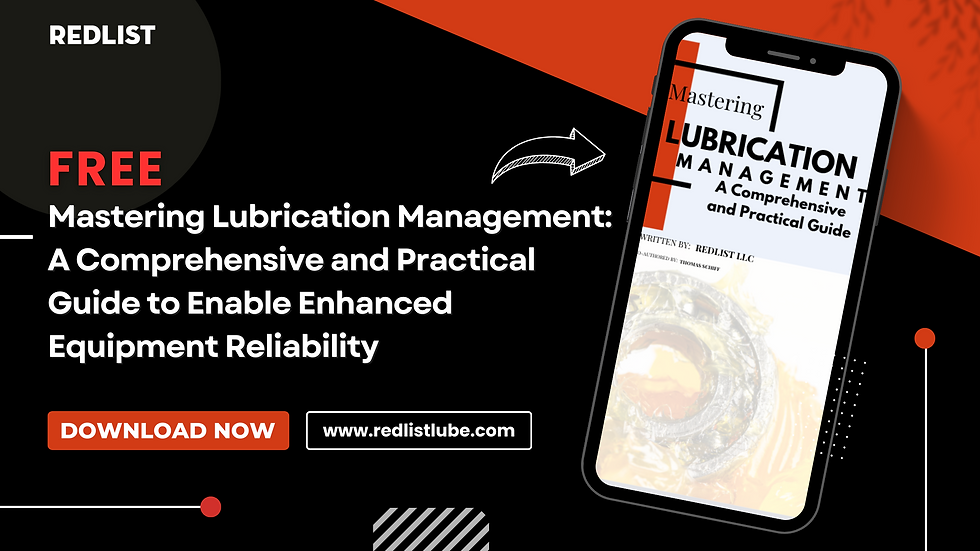Lube Management Training Plan for a Successful Lube Program
- Redlist
- May 2, 2024
- 4 min read
Updated: Jun 17, 2024

A lubrication or lube program is undoubtedly one of the pillars of asset maintenance management. It is key to maintain reliable and optimized machines and equipment.
A successful lube program, in turn, is only as strong as its foundation: Your lube management training plan. In this post, we discuss building a robust training plan for a successful lube program, from planning to implementation and continuous improvement.
You will also learn about Redlist’s Lubrication Management Software, a cutting-edge tool that provides valuable support for your lube management training plan.
Lube Management Training Plan Objectives
Any effective training plan seeks to achieve the following objectives:
Unlock Skill Development
Skill development should be the top priority when it comes to lube management training. To start, a training plan must evaluate the trainees’ current skills and knowledge. Next, the plan must identify the ideal resources, materials, and methods needed to develop or improve upon these skills.
A lube management training plan focused on skill development guarantees that your team members absorb essential training knowledge and apply it in their daily work. Thus, you ensure that the money, time, and effort invested in the training program are not wasted and result in long-lasting benefits.
Unpack Implementation Strategy
Another critical purpose of a lube management training plan is to unpack a lube program’s current implementation strategies. A training plan achieves this objective by presenting and discussing these strategies, and if available, gathering improvement suggestions from the trainees.
Any implementation strategy involved in lube management must be clear and understood by all involved personnel for successful results. Including lube program strategies, both those already in place and those still being planned, in a training plan broadens understanding and promotes personnel improvement and collaborative culture.

Developing a Comprehensive Lube Management Training Plan
When developing a lube management training plan, there are several areas of consideration. The following areas are essential and must be included in a successful and comprehensive training plan:
Lubrication Training
Effective lube management relies on its lubrication training program to achieve its objectives. Training on lubrication can vary in topic, structure, and scope depending on the purpose, skill set, and other learning requirements of the trainees.
When developing a lubrication training program, we aim for consistency, specificity, and practicality. Any information you disseminate must be consistent across all trainees, updating them of any changes as soon as possible.
Furthermore, your trainees can better grasp and absorb information when they can apply it to their specific tasks and can experience them first-hand.
Maintenance Training
An effective training plan must involve training personnel in general maintenance processes, procedures, and related instructions. It must provide trainees with an overview of how an organization’s maintenance system works and how their lube-related tasks fit into this system.
Although other maintenance information, tasks, and methods are non-lube related, these have direct effects on lube management implementation. Proper lube management is only possible when lubrication tasks are part of the whole maintenance system and executed in synergy with other maintenance tasks.
Asset Management Education
As an integral part of asset management, a lube management training plan must also include training lubrication personnel on the importance and principles of asset maintenance. Again, any information or method included in this training must be trainee-appropriate and in line with a particular purpose.
Equipment Reliability Training
Equipment reliability is another essential lubrication-related topic that must be considered when developing a lube management training plan. Equipment or asset reliability is the ability of assets to perform at the optimum expected level under certain conditions. Equipment reliability is the aim or bottom line of any maintenance program. Thus, including this topic in the lube management training plan is critical for its success.
Redlist Revolutionizes Lube Management Training
Redlist comes with important functionalities that are fast becoming indispensable when keeping up with the demands and challenges faced by modern industries. The following are the valuable solutions Redlist provides that can revolutionize your lube management:
Centralized Training Hub
Redlist can serve as a training hub with its intuitive interface and cloud-based storage. Digital information on equipment reliability, lubrication best practices, and asset management can be stored and accessed from one source. Thus, trainees and team members involved can access consistent information easily, ensuring better training applications and results.
Real-Time Information Sharing
With digital information and mobile access, Redlist allows training information to be shared in real time. This further promotes consistency and collaboration among trainees. Real-time information also reduces misinformation or information delay, which can contribute to unreliable assets and expensive downtime.
Custom-Tailored Training Plan
Redlist can help you customize a training program to meet the specific needs of your company. Your training needs, i.e., trainee skill set, purpose, etc. must dictate the training materials and methods you develop. Redlist’s user-friendly interface gives you the freedom to personalize the training materials and information that each trainee can have access to, thus ensuring better training results.
Training & Performance Tracking
Redlist also lets you keep track of staff training certifications and monitor their progress with skills training. A gold mine used Redlist for this purpose and was successful in boosting employee advancements through training and improved employee retention:
Before streamlining their training process with Redlist, 40.51% of the mine’s technicians were level four or level five. After five months, their workforce advanced to 51.89% at these two highest levels of technician experience. This resulted in haul trucks spending less time in the shop because more skilled technicians were available to work on equipment and handle more of the maintenance responsibilities.

Redlist: Your Digital Solution for Lube Management Training Excellence
Open up your lube management training plan to a digital revolution with Redlist and transform your lube management to achieve your bottom line. Schedule a free demo to experience a world of maximum efficiency, long-lasting assets, and low operational costs.

Comments